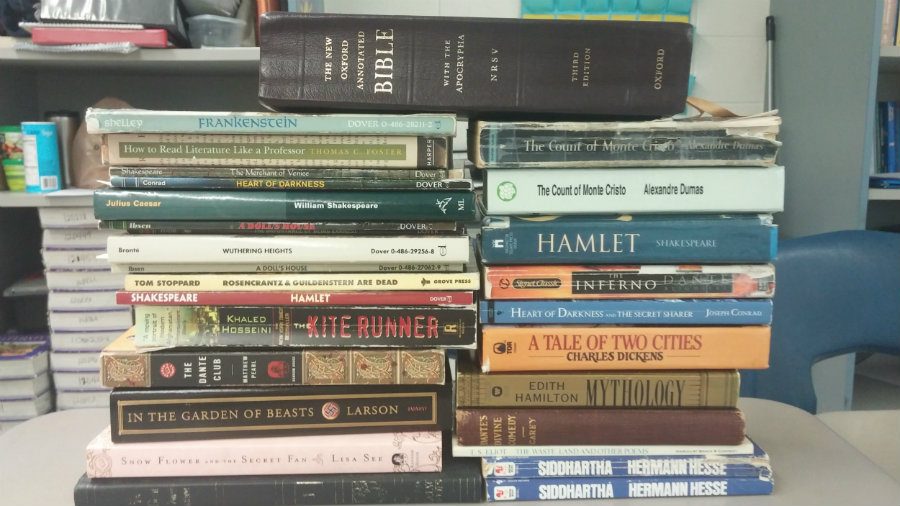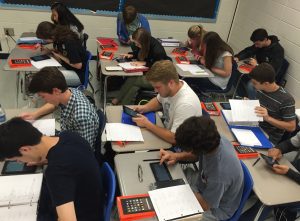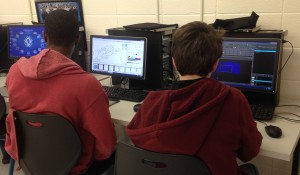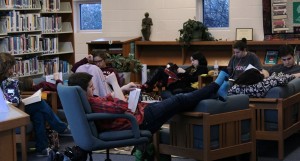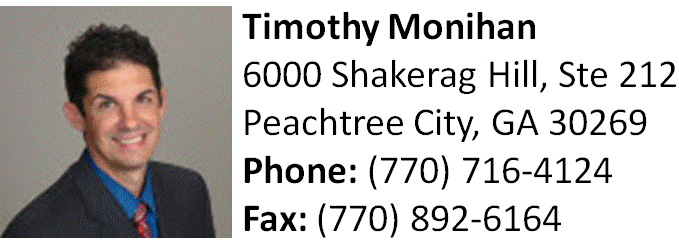Starr’s Mill adds Bible to curriculum
The primary literature resource of the Bible as Literature class rests on top of a tower of other works Genovese uses when teaching his other literature classes. The Bible as Literature class will be based around helping students with “critical thinking, communication and writing skills while using the Bible as a basis,” Genovese said. The first semester will focus on the Old Testament and the second semester on the New Testament.
May 12, 2016
“The Bible is arguably the most influential work,” English teacher Shad Genovese said. Many classic works of literature, philosophies and cultures all allude to the Bible, and Genovese felt like this religious text was too important to exclude from students’ educations.
Genovese will add the Bible as Literature elective class to his schedule next year. The first semester of the class will focus on the Old Testament, or the Hebrew scriptures, as Genovese prefers to refer to it, and the second semester will center around the New Testament. He has high hopes that this class will demonstrate how the Bible influences western literature.
This class comes with the responsibility of upholding the necessity of separation of church and state. Genovese told assistant superintendent of student achievement Terry Oatts that “there is no target audience” for the class.
He warned against “randomly placing a student of any religion or no-religion in a class on the Hebrew scriptures or the New Testament if s/he does not willingly want to study them.”
With Genovese’s experience in teaching different literature, he finds it easy to keep the class objective “because when you teach a book, you just teach it from that person’s perspective without having to agree with it.”
Genovese first thought of the idea for this class when Starr’s Mill converted to a seven-period day and new electives were a necessity. Shortly after, he began to look into creating this new elective that will help students with “critical thinking, communication and writing skills while using the Bible as a basis,” Genovese said.
In order to submit the class, Genovese required a state course number. Genovese had to complete a rationale statement describing the purpose of the class, which includes increasing students’ reading literacy and critical thinking skills, understanding the “influence of both the Hebrew Bible and New Testament in western historical, sociological, political, artistic, and philosophical culture,” and preparing them for other literature classes.
These “academic electives would be the first of their kind in our district,” Oatts said. Oatts is in charge of reviewing the new course approval requests submitted by schools to the district office.
Content area coordinators had to review the curriculum points to decide if they coincide with the state requirements before the class could be offered at the Mill.
When finalizing the courses approval, the secondary English language coordinator, the superintendent and the executive cabinet were all consulted and “ultimately determined that the courses could enhance Starr’s Mill’s academic literary elective courses,” Oatts said.
Genovese has already started preparing for the class by creating a tentative syllabus and will continue to gather more materials for the students throughout the summer. He plans to use the New Oxford annotated edition of the Bible as the textbook but has yet to be notified if his request has passed through the county.
The Bible is only not the only piece of literature that will be compared and contrasted throughout the course, but it will be the main focus point.
Many of the materials that will be used will include early documents such as the Emancipation Proclamation, Genovese said, to study whether the Bible supports slavery as some claimed during the Civil War. “I would ask the question, were those people correct or not?” Genovese said in his rationale.
The main purpose of this class is to improve critical thinking by analyzing historic literature. “The only way to think critically is to consider all sides of an issue,” Genovese said. He cites archetypes and allusions to creation stories, original sins, apocalypse, resurrection, the concept of heaven, and more as reasons to study the text.
Taking this class will allow students a “better understanding of what the Bible really says,” Genovese said. He feels it’s “important to know why the Bible is there.”
Genovese chose to make the class available to all grade levels and it is currently scheduled for one period. However, the number of periods that the class is offered could change in the future depending on the demand for the class.


